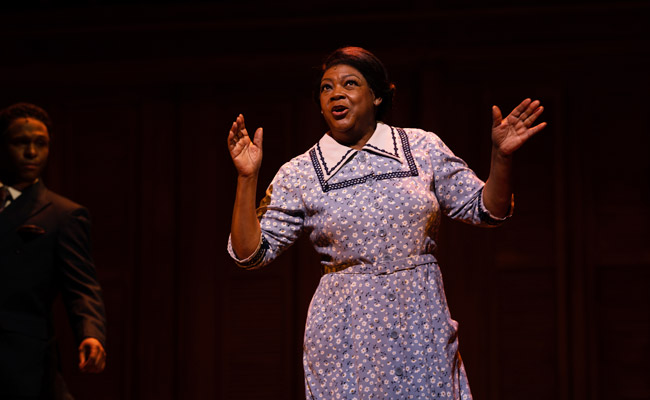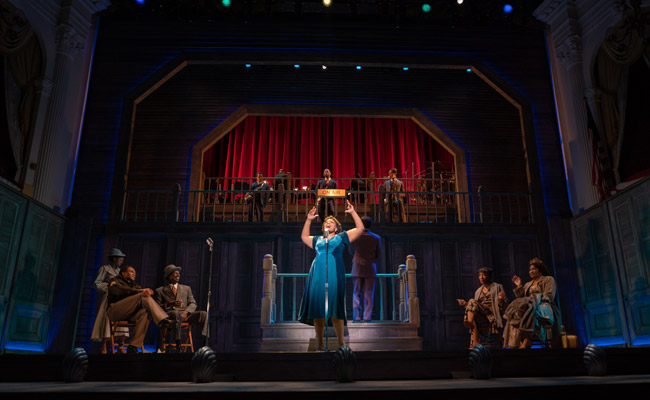
André Chung
Anyone familiar with music history, particularly the advent of the rock era, is sure to know that Elvis Presley is the King of Rock and Roll. What a lot of people don’t know is that Elvis’ musical style was not initially his own, it was something he honed into his own, as did many others of the time like Jerry Lee Lewis and Johnny Cash. Their style of music grew out of the blues, jazz and gospel of Black musicians that white audiences mostly never heard of, like ‘Big Mama’ Thornton (the originator of ‘Hound Dog’ that Elvis made famous) and Sister Rosetta Tharpe, whom many consider to be the godmother of rock and roll, even though her roots were firmly in the gospel genre. And now in our current political climate where teaching and learning about our country’s history is becoming a crime, the Ford’s Theatre in Washington DC is giving the musical biography Shout Sister Shout! it’s East Coast premiere, hoping to shed a little light on Rosetta and her music, finally giving her her rightful place in musical history.
Shout Sister Shout! starts off backstage with Rosetta being interviewed — and yes, she does mention Elvis and how he took their music and made it his own — but then we’re transported back to her beginnings in the church, her feelings of not being appreciated for her guitar skills (something at that time seen only as a masculine act) but loving preaching the Word with her evangelist mother (who was also looked down on for doing what was also considered a man’s work) while still hoping to one day find a man of her own. Before she knows it, the Reverend of her church offers her the most bizarre proposal ever when he tells the congregation that she is going to be his wife. Mother Katie, with a veil and bouquet in her purse, is ready to see her daughter happily married but that happiness quickly turns to turmoil when Rosetta can’t resist joining some street musicians in a ‘worldly’ musical number, and the relationship with her husband turns violent. Rosetta, however, is told that she has the talent to be noticed and is offered a spot performing at the famous Cotton Club in New York City. Against her mother’s wishes, Rosetta makes her way to the Big Apple and quickly becomes a new musical sensation with radio programs beckoning, and shows lined up at the Apollo and Carnegie Hall. But while Rosetta wants to stay close to her gospel roots, she finds that her recording contract also demands that she perform more secular music as well, but no matter what genre she’s working in, she develops a reputation for being able to shred those chords on the electric guitar. But how high can she go before it all comes tumbling down?
I have to admit I did not know anything about Sister Rosetta Tharpe before seeing Shout Sister Shout! except her name. From what I’ve learned in my research for the show, she was indeed known for her guitar skills, which is often mentioned in the show but almost as an aside when it is, and for being the first person to introduce the electric guitar into gospel music (something that the show does not make a big enough deal of). But the quickly paced show still does touch on many of the key moments of Rosetta’s life, although when exactly the show takes place is sometimes hard to follow except for the one moment she references the soldiers fighting in that world war, but the span of time covers about 40 years from the 1930s to the early 1970s (Tharpe died in 1973). Tharpe’s 1964 European tour is also mentioned but is not part of the main story. One romantic subplot in the second act may also raise some eyebrows as it seems to come completely out of nowhere, and its authenticity is dubious at best (both parties involved have said it was just vicious rumors) which makes its inclusion in the show questionable as audiences will perceive it as fact.
All of that aside though, Shout Sister Shout! makes a joyful noise thanks to the star-making performance of Carrie Compere as Rosetta Tharpe, reprising the role from the second version of the show produced in 2019 by the Seattle Repertory Theatre. Compere is a triple threat on that stage, acting, singing and shredding that guitar, raising the roof whenever she opens her mouth in song. She brings an innocent vulnerability to Rosetta at the beginning, becoming more sure of herself and more mature as her career and popularity blossoms. But even as she becomes a strong woman who knows what she wants, personally and professionally, there is still that hint of vulnerability under the surface. Compere gives a masterful performance from start to finish, and she is almost always on stage for the entire length of the show.

André Chung
Carol Dennis is also fabulous as Rosetta’s mother Katie Bell, always there to offer her motherly advice but not afraid to tell Rosetta exactly what she thinks after she feels her daughter has strayed too far from the Lord in her musical career. And let me tell you, she can sing with a powerful voice, drawing all eyes to her. One moment I really did appreciate comes in the midst of the questionable romance where Katie tells Rosetta it’s not her place to judge, that’s up to the Lord. It’s hard to know if she actually did say that to Rosetta, but nonetheless it is a great line of dialogue and a good piece of advice particularly for those steeped in religion who are trying to legislate how people live their lives. Dennis makes Katie a loving, stern, compassionate person, and she and Compere have a great chemistry that makes the relationship believable.
Felicia Boswell, who is mostly part of the ensemble, gets to shine in the second act when she takes on the role of Marie Knight, a singer and musician Rosetta lays eyes on while attending a performance by Mahalia Jackson (the stunning Kelli Blackwell, who absolutely shines in her one scene). Boswell can also belt out a tune, and manages to dance around the script’s not-so-subtle suggestions about her relationship with Rosetta without making it explicit. It is interesting how she does appear at the top of Act I, but we don’t put those pieces together until she reappears in Act II. She probably has one of the hardest lines to walk with all the innuendo — and tragedy — and she does it extremely well.
The large ensemble cast is full of outstanding performances including Joe Mallon, who appears mostly as Rosetta’s manager; Sinclair Mitchell (Reverend Tharpe); Nia Savoy-Dock, Raquel Jennings and Jalisa Williams as Cotton Club showgirls and other ensemble roles; Kevin McCarter as Dizzy Gillespie; Joseph Anthony Byrd turns it out as Cab Calloway, while Jamal Antony Shuriah and Jarran Muse shine as the tap dancing Nicholas Brothers (in addition to their other ensemble roles), and ensemble player David Rowen, who also plays Neckbone and Lucky Millinder. The show is packed with talent, with many of them having appeared on Broadway and in regional theatre and national tours. The casting directors for this show need to take a bow for that talent they have put on that stage.

André Chung
And speaking of the stage, Shout Sister Shout! has really interesting production design, borrowing a major element from Les Misérables and Hamilton — a turntable stage. The main piece of scenery is a large wall with doors that open and close while the turntable delivers specific props and set-pieces for the scene. It’s a really cool way to smoothly move from scene to scene without the need for massive sets. But the wall itself has a few secrets, notable a walkway and a piece of the wall that raises to reveal the orchestra high above the main stage. It’s all utilized really well so I tip my hat to Tim Mackabee and his crew. Same for the lighting design by Alan C. Edwards, bathing the stage in blues, purples, reds … all the colors of the rainbow, and then reducing everything to a single spotlight in the darkness when necessary. It really was some of the most beautiful lighting I’ve ever seen for a stage production. Costumes, hair and make-up are all on point, with Compere often wearing a wig on top of a wig and a dress on top of a dress to quickly change scenes. My only quibble is with the sound design which sometimes featured the music over the dialogue a bit too much in places that made it seem like the actors were shouting their lines to be heard. The music, however, never drowns out anyones marvelous singing. Kenneth L. Roberson keeps things moving, utilizing the stage to its fullest, as well as the entire theatre. An additional walkway area has been placed in front of and a few steps below the stage, and at one point the ensemble makes their way to the stage from the back of the theatre. If you’re sitting in the second level, you’re going to miss a lot of that action unless you’re in the front row so try to get tickets in the orchestra if you can.
This was my first visit to Ford’s Theatre, and this production totally blew me away. I’ve seen professional touring versions of Broadway shows that weren’t as high quality as this production. Even with my minor issues, it’s a show that should be — need to be — seen, and I hope it has a long life on the road or even on Broadway so the general public can get acquainted with Sister Rosetta Tharpe.
Shout Sister Shout! runs about 2 hours 30 minutes with one intermission. Recommended for ages 12 and up.
Shout Sister Shout! runs through May 13 at Washington DC’s Ford’s Theatre. Visit the official website for more information.
